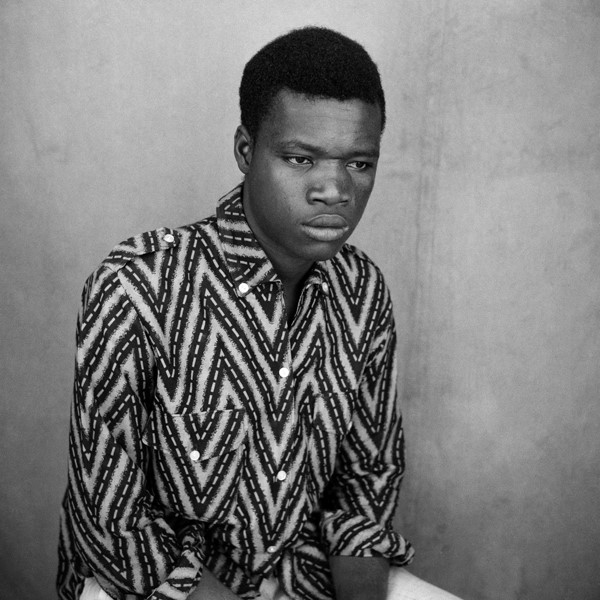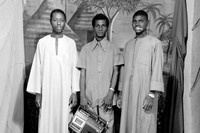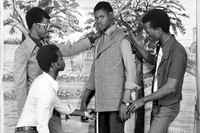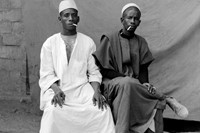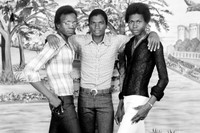This week, for the first time, the remarkable studio photography of Hamidou Maiga is brought to light in his first solo exhibition, Talking Timbuktu at London's Jack Bell Gallery.
This week, for the first time, the remarkable studio photography of Hamidou Maiga is brought to light in his first solo selling exhibition, Talking Timbuktu at London's Jack Bell Gallery. Initially trained as a mason in Timbuktu, Maiga’s career took a new direction when he purchased his first camera, a medium format Souflex, in the 1950s. Learning the fundamentals of photography through photojournalism he then traced the route of the River Niger, establishing a name for himself through his distinctive outdoor studio portraits – shot against striking painted backdrops with carefully chosen props and costumes. Photographing villagers, dignitaries, musicians, artists and sportsmen, Maiga’s studio became a hub for creatives, a place for people to meet and exchange ideas whilst also having their picture taken. Maiga’s images also offer a document of Malian society, presenting the great sense of freedom and confidence after Mali’s transition from a cosmpolitan French colony to an independent African nation.
Here we speak to 79-year-old Maiga who continues to live and work in Bamako. With thanks to Maiga’s son for acting as the translator in this interview.
How did you first get into photography?
I was surprised to find how poor the quality was of the photography available at the time. I decided to learn the art in Mopti – to make high quality images and then take up the profession in Timbuktu. Photojournalism was the best avenue to go down to perfect these skills. Having completed my apprenticeship I bought a complete set of laboratory equipment from a Ghanaian colleague and became one of the first photographers to take a camera out into the Niger region.
Did you feel a pressure to pursue your trained profession as a mason?
It was a big risk for me – everything I had earned through masonry I was obliged to invest in learning the art of photography. Cheaper material did not produce beautiful photos. I threw everything I had into making images.
How well accepted was your practice in an early Mali?
Well at the time, I was one of the only photographers working like this in the Niger Region. When I set up my first studio in NʼGouma, my clients had never had their photograph taken before. I benefited from having the only professional set up – my clients were the curious few who couldnʼt believe the idea of fixing an image on paper.
What drew you to create outdoor studio portraits?
At the beginning, I wanted to be like the outdoor plate camera photographers of Mopti. Their cameras were locally made and they would affix a 5 x 4 lens – I was amazed how self contained the whole operation was. A whole darkroom inside a little box. As I was hungry for work I started to travel farther afield. I traced the route of the Niger from Mopti to Timbuktu. The scene was constantly changing and I was mobile enough to move with it. I met a lot of interesting people. Dealing with the challenges of outdoor studio photography – light, subject, framing – made it a good place to form up my abilities as a photographer.
Who was your favourite sitter to photograph and why?
I was interested in the art of the portrait – people who came to see me wanted a beautiful photo. I always knew how to get the shot set up just right, the way they positioned the hands, the tilt of the head, the way they sat or stood. This whole process fascinated me. I could really try to get to know the person in order to better represent them. I think the younger clients were my favourites to work with. They burned with the passion and enthusiasm of youth!
Does anyone or anything in particular inspire your photography?
Malick Sidibe of course has been a great friend to me. We have worked together over the years and I admire his great success.
Still living in Mali – what keeps you there and what do you find so fascinating about the people who you have photographed throughout your career?
Over the years, as well as photographing villagers I also photographed dignitries, artists and musicians. I became well known in these parts – everyone knew my name. I loved the buzz – the studio became a site where people would meet and exchange ideas. All these different worlds would collide in one room through the people I met. It was a real melting pot.
While I find all these different types of people fascinating they have also shown a great deal of respect towards me over this time. It has been a time of immense change for Mali and I feel I capture that in my photographs.
Do you continue to photograph today – if so what are you working on at the moment?
Yes, I will always be involved with photography. Iʼve just started working on a new series of portraits in the region of my hometown Timbuktu.
Text by Lucia Davies
Hamidou Maiga, Talking Timbuktu runs 23 March – 30 April at Jack Bell Gallery, London.
